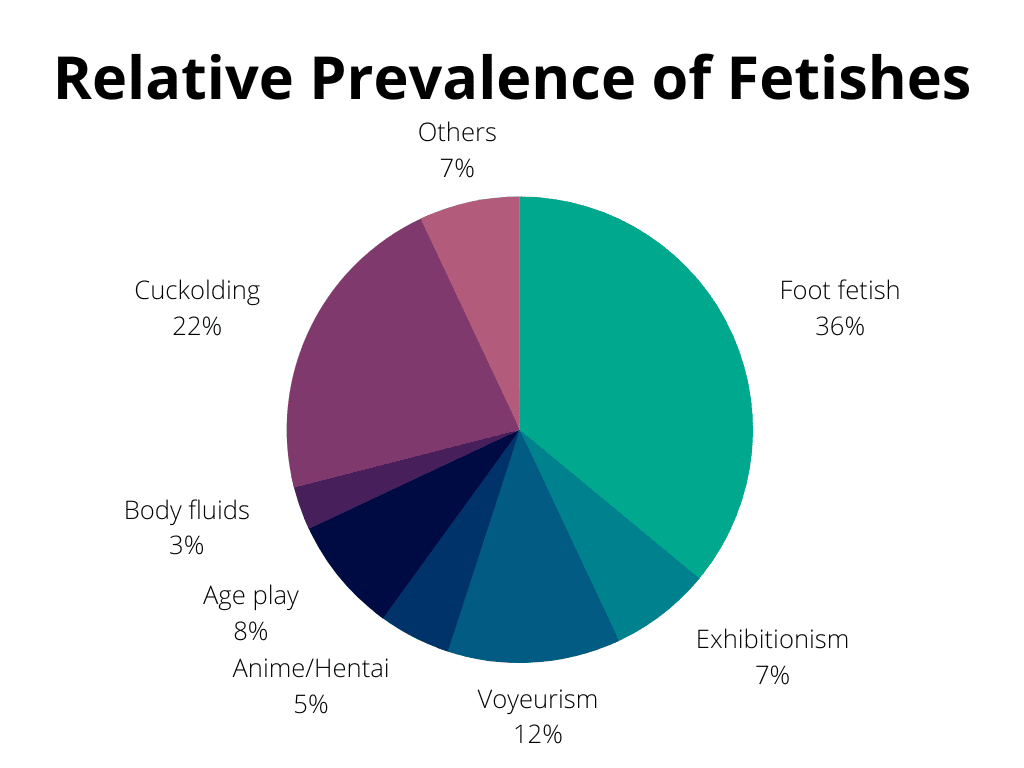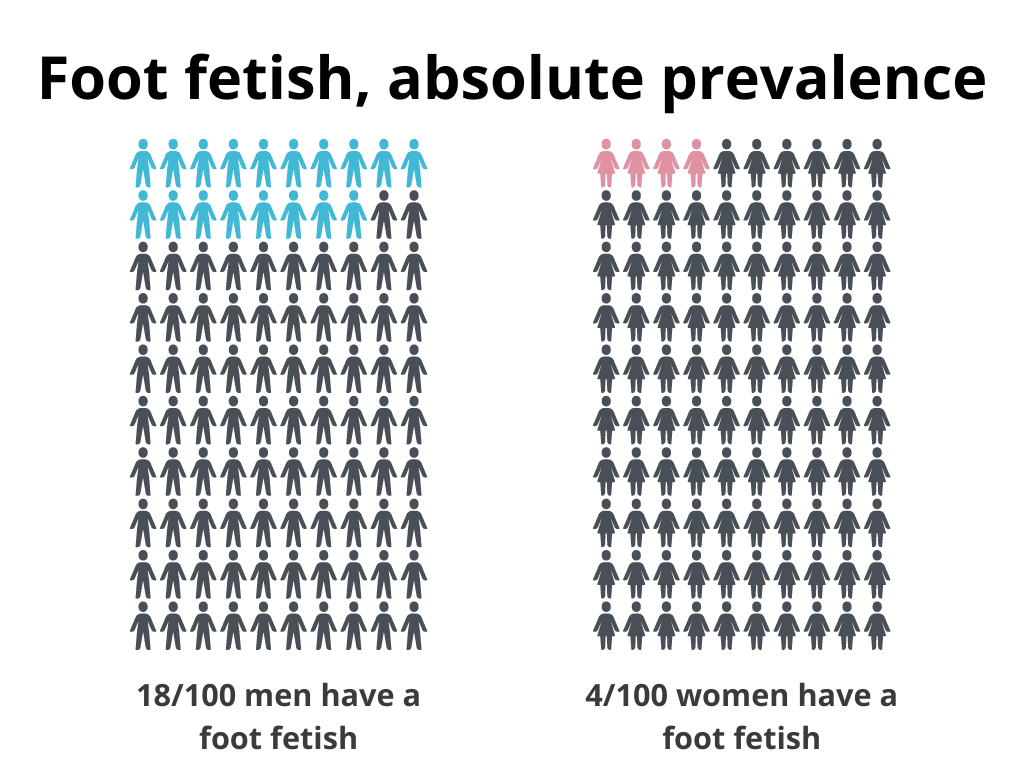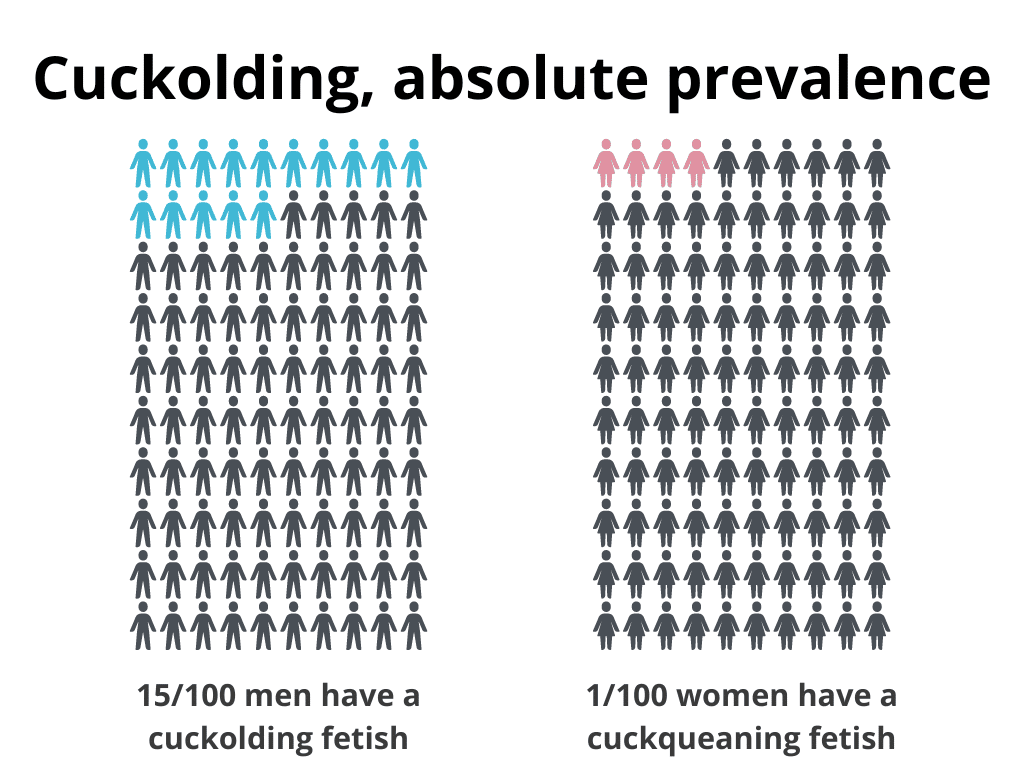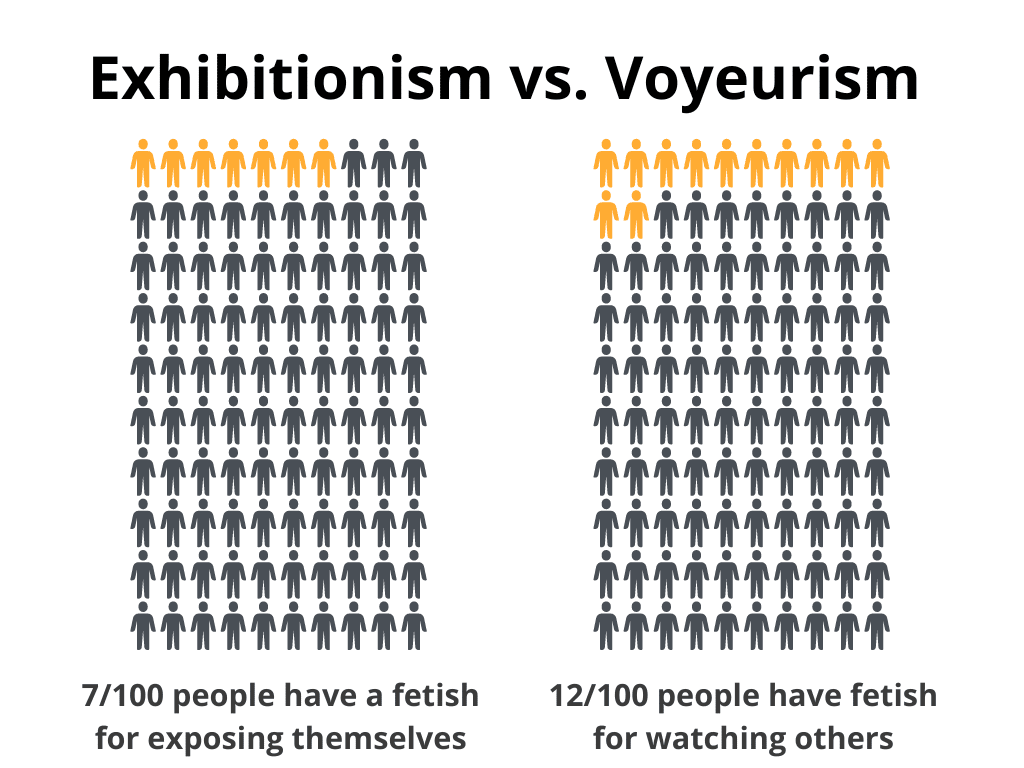![Most Common Fetishes [+20 Fetish Statistics]](https://wp.bedbible.com/wp-content/uploads/2024/05/Fetish-Statistics.png)
Human sexuality is a vast and intricate tapestry, with desires as varied as the individuals who harbor them. Bedbible’s latest research delves deep into the realm of fetishes, shedding light on the prevalence and nature of various kinks.
With a staggering 655,341 data points gathered from 844 online communities and insights from over 112,000 individuals, this comprehensive study offers a unique perspective on the world of fetishism. From the enduring allure of foot fetishes to the emerging trends on platforms like TikTok, this report provides a holistic view of the myriad ways people experience and express their unique sexual inclinations.
Whether you’re curious about the most common fetishes in different states or the distinction between kinks and fetishes, this statistical piece offers a captivating journey into the depths of human desire.
In this statistical piece you’ll find:
- Most Common Fetishes
- NPC Fetish on TikTok
- How normal is it to have any kind of fetish or kink?
- Multiple fetishes and kinks per person
- By State (most common fetishes)
- By Region (most common fetishes)
- Difference between kinks and fetishes
- Understanding Fetishistic Disorder
- Methodology
Key Findings
- 25% have tried fetishism
- 1 out of 3 have had sex in a place they risked getting caught
- Foot fetish is the most common fetish of all (11% of the population have a foot fetish) – more popular than cuckolding (8%), voyeurism (5%), and age play (3%).
- 18% of men have a foot fetish, while only 4% of women have a fetish for feet and toes.
- Age play is the most popular fetish amongst women (6%), while foot fetish is the most popular fetish among men (18%).
- Voyeurism (watching others) is twice as common in the population compared to exhibitionism (exposing yourself to others).
- Cuckolding/cuckqueaning (fantasizing about an adulterous partner) is over 20 times more common among men compared to women.
- Women fetishize anime/hentai more than men.
- 12% of people have a fetish for watching others have sex
Most Common Fetishes
The results of our systematic repetition of the study by Scorolli et al. (2007) showed very similar results. However, new categories have been introduced, as our search basis expanded.
Additionally, the table below also contains survey data on the absolute prevalence of different fetishes in our nationally representative study.
| Fetish | Sexological classification | Relative Prevalence | Absolute Prevalence (men, women) |
|---|---|---|---|
| Feet, toes | Podophilia, foot fetish | 36% | 11% (18%, 4%) |
| Adulterous partner | Cuckolding (for men), cuckqueaning (for women) | 22% | 8% (15%, <1%) |
| Infantilism, DDLG (daddy-dom little girl) | Voyeurism | 12% | 5% (6%, 4%) |
| Age play | Body modifications (tattoos, pierceing, etc.) | 8% | 3% (<1%, 6%) |
| Public exposure (naked or having sex) | Exhibitionism | 7% | 3% (4%, 2%) |
| Anime and Hentai | Ecchi, Omorashi | 5% | 2% (1%, 2%) |
| Body fluids (blood, urine, etc.) | Golden/brown showers, watersport, urophilia, scatophilia, lactaphilia, menophilia, mucophilia | 3% | 1% (1%, <1%) |
| Body size (obesity, tall, short, etc.) | Chubby chasers, nanophilia | 2% | 1% (ns, ns) |
| Muscles | Cratophilia (strength), sthenophilia (muscle) | 2% | <1% (ns, <1%) |
| Dressing and acting as animals | Anthropomorphic, furries | 2% | <1% (ns, ns) |
| Tattooing, piercing, ringing, stigmatophilia | Body modifications (tattoos, piercings, etc.) | 1% | <1% (ns, ns) |
| Belly or navel | Alvinophilia | <1% | <1% (ns, ns) |
| Ethnicity | Allotriorastry, miscegenation, xenophilia | <1% | <1% (ns, ns) |
| Breasts | Mammaphilia, mammagynophilia, mastofact | <1% | <1% (<1%, ns) |
| Legs, buttocks | Crurofact, Pygophilia | <1% | <1% (ns, ns) |
| Mouth, lips, teeth | Odontophilia | <1% | <1% (ns, ns) |
| Body hair | Hirsutophilia, gynephilus- and pubephilia (pubic hair fetish), depilation | <1% | <1% (ns, ns) |
| Body odor | Mysophilia, osmophilia | <1% | <1% (ns, ns) |

Foot fetish is the most common fetish
The research showed similar data on the prevalence of foot fetishes compared to other types of fetishes.
Foot fetish is the most prevalent fetish relative to all other fetishes measured on how many participants and activity can be measured in online communities. In other words:
- 36% of online activity around different fetishes is related to foot fetish.
The same picture formed when we measured the prevalence of foot fetish in our nationally representative survey:
- 11% of the population indicate that they have a fetish for feet and toes (18% men, 4% women)

How Common is Cuckolding and Cuckqueaning as a Fetish
The second most predominant fetish recorded in our study is the fetish of an adulterous partner.
For men, this fetish is called cuckolding, while for women it is called cuckqueaning.
Our study showed that:
- 22% of online groups and chats on fetishes revolve around cuckolding and cuckqueaning.
- 8% answered they have a cuckolding fetish when asked, making it the second most popular fetish.

Exhibitionism and Voyeurism
Collectively exhibitionists and voyeurists make up over 8% of the population.
- 12% of the population report to be a voyeurist.
- 7% of the population report to be an exhibitionist.

NPC fetish on TikTok
The Rise of the NPC Fetish on TikTok
In the ever-evolving world of TikTok trends, the NPC (Non-Player-Character) fetish has recently taken center stage. But what exactly is this trend, and why has it gained such traction?
Understanding the NPC Fetish
Video game NPCs, or Non-Player-Characters, are characters not controlled by human players. They typically follow scripted lines, providing tasks or information to make the gaming world feel more immersive. Drawing inspiration from these characters, NPC streamers on TikTok emulate the characteristics of video game NPCs, primarily through repetitive actions and dialogue. The aesthetics often borrow elements from other entertainment genres, such as sci-fi or anime.
The core appeal of these streams seems to lie in the NPC streamers’ portrayal as emotionless, personality-less human shells. This gives viewers the illusion of being in control, much like a programmer controlling a character. In exchange for token payments via TikTok’s sticker function, performers like Pinkydoll, a prominent figure in this trend, will repeat specific phrases for extended periods. The endurance and performance skills required for such streams are commendable, but many have noticed a distinct sexual undertone to the content.
The Controversy and Popularity
The NPC fetish trend has sparked debates online. Some argue that it caters to viewers with control or coercion kinks, likening the content to online sex work platforms like Fansly and OnlyFans. Concerns have also been raised about the dehumanizing nature of the content and its accessibility to younger audiences on TikTok.
However, it’s essential to recognize that streamers like Pinkydoll and Cherrycrush_tv are willing participants. They are aware of the nature of their viewership and seem to be comfortable with it. Their popularity is undeniable, with Pinkydoll amassing over 261K followers in a short span and cherry_crush TV not far behind with 300K followers. Their live streams attract tens of thousands of viewers, and their influence continues to grow.
How normal is it to have any kind of fetish or kink?
Sexual fetishes, often considered a private aspect of one’s sexuality, have been the subject of various studies to understand their prevalence. A recent study, focusing on participants from America and Canada, shed light on the interest and engagement levels in fetishes among different genders. Here’s a breakdown of the findings:
| Gender | Interest in Fetish | Engaged in Fetish Behavior | Both Interest & Behavior |
|---|---|---|---|
| Men | 58.1% | 53.8% | 54.3% |
| Women | 45.7% | 41.9% | 46.2% |
Interpreting the Data
From the study, it’s evident that a significant percentage of both men and women have shown interest in fetishes. Furthermore, a notable proportion has not only expressed interest but also engaged in fetish-related behaviors. The data underscores the idea that fetishes are a common aspect of human sexuality, with many individuals exploring and embracing their unique desires.
Multiple fetishes and kinks per person
The world of fetishes is as diverse as the colors of a rainbow. Just as one might have a penchant for red shoes and another for blue scarves, the realm of fetishes is vast and varied. But how common is it for someone to have more than one fetish?
Diving into the Data
A detailed study analyzing 48 clinical cases of fetishism provided some intriguing insights into the number of fetishes an individual might have:
| Number of Fetishes | Number of Participants | Percentage of All Participants |
|---|---|---|
| One fetish | 17 | 35.4% |
| Two fetishes | 9 | 18.8% |
| Three fetishes | 12 | 25% |
| Four fetishes | 6 | 12.5% |
| Five to Nine fetishes | 4 | 8.3% |
| Total | 48 | 100% |
The Longevity and Interrelation of Fetishes:
Fetishes, once developed, tend to be enduring aspects of an individual’s sexuality. It’s not uncommon for someone to harbor multiple fetishes simultaneously. Rather than one fetish fading away to make room for another, they often coexist harmoniously.
For many, these fetishes can be interconnected. For instance, someone might have a fetish for feet, which extends to shoes and further to stockings. These fetishes, while distinct, share a thematic connection.
However, it’s also worth noting that not all fetishes an individual might have been linked. The human psyche is complex, and the origins and connections between fetishes can be as unique as the individual.
In conclusion, the world of fetishes is a rich tapestry of desires and inclinations. Whether one has a single fetish or several, each is a unique expression of human sexuality.
The Kinky Map of America: Most Common Fetishes by State
From sea to shining sea, America is a diverse tapestry not just of cultures and landscapes, but also of kinks and fetishes. Let’s embark on a journey through the states, exploring the unique and varied sexual preferences that make up the fabric of the nation.
State-by-State Most Popular Fetishes and Kinks
| US State | Fetish |
|---|---|
| Alabama | Yoni egg |
| Alaska | Fisting |
| Arizona | Latex |
| Arkansas | Voyeurism |
| California | Wax play |
| Colorado | Masochism |
| Connecticut | Sadism |
| Delaware | Group sex |
| District of Columbia | Masochism |
| Florida | Piercings |
| Georgia | Hair fetish |
| Hawaii | Masochism |
| Idaho | Erotic electrostimulation |
| Illinois | Roleplay |
| Indiana | Armpits |
| Iowa | Group sex |
| Kansas | Sports gear |
| Kentucky | Scene play |
| Louisiana | Sadism |
| Maine | BDSM |
| Maryland | Masochism |
| Massachusetts | Nylons |
| Michigan | Humiliation |
| Minnesota | Edge play |
| Mississippi | Sports gear |
| Missouri | Used underwear |
| Montana | Sadism |
| Nebraska | Group sex |
| Nevada | Armpits |
| New Hampshire | Sounding |
| New Jersey | Group sex |
| New Mexico | Chastity belts |
| New York | Leather |
| North Carolina | Suits |
| North Dakota | Cuckolding |
| Ohio | Uniforms |
| Oklahoma | Impact play |
| Oregon | Used underwear |
| Pennsylvania | Balloons |
| Rhode Island | Foot fetish |
| South Carolina | Dominance |
| South Dakota | Masochism |
| Tennessee | Suits |
| Texas | Whipping |
| Utah | Voyeurism |
| Vermont | Edging |
| Virginia | Balloons |
| Washington | Gagging |
| West Virginia | BDSM |
| Wisconsin | Sports gear |
| Wyoming | Bondage |
Regional Fetish Trends
When we zoom out and look at broader regions, certain patterns emerge. Here’s a breakdown of the most searched fetishes on Google by region in the U.S..
| Region in the US | Fetish |
|---|---|
| Midwest | Group sex and sports gear |
| Northeast | Balloons, BDSM, edging, foot fetish, group sex, leather, nylons, sadism, and sounding |
| South | Suits and masochism |
| West | Masochism |
The difference between kinks and fetishes
The terms “kink” and “fetish” are often used interchangeably, but they have distinct meanings within the context of sexuality:
- Kink:
- A kink refers to any unconventional sexual practice, desire, or fantasy that goes beyond traditional societal norms.
- Kinks can range from light bondage, and role-playing, to more intense practices.
- It’s worth noting that what is considered “kinky” can be subjective and varies across cultures and individual preferences.
- A kink doesn’t necessarily need a specific object or specific situation to become aroused. It’s more about the act or scenario itself.
- Fetish:
- A fetish specifically refers to a strong sexual fixation on a particular object, body part (that’s not conventionally viewed as sexual), or situation. It’s not just that someone likes the object or situation — it’s that they have a deep-seated need for it to achieve sexual gratification.
- For instance, someone might have a foot fetish, where they are especially aroused by feet. They might need to interact with, touch, or see feet to feel sexually satisfied.
- Fetishes can be about materials (like leather or latex), situations, or specific objects.
- For individuals with a true fetish, the absence of the fetish object can make sexual gratification difficult or impossible.
| Parameter | Kink | Fetish |
|---|---|---|
| Definition | An unconventional sexual practice, desire, or fantasy. | A strong sexual fixation on a particular object, body part, or situation. |
| Scope | Requires a specific object or situation for sexual gratification. In its absence, satisfaction may be difficult. | Specific focus on an object, body part (not conventionally viewed as sexual), or situation. |
| Requirement | Doesn’t necessarily require a specific object or situation for arousal. | Requires the specific object or situation for sexual gratification. In its absence, satisfaction may be difficult. |
| Examples | Light bondage, role-playing, sensation play, etc. | Foot fetish, leather fetish, latex fetish, etc. |
| Societal Perception | Often viewed as diverging from traditional sexual norms. | Often associated with a deeper level of fixation or obsession. |
Understanding Fetishistic Disorder: When Fetishes Go Beyond the Norm
Sexuality is deeply woven into the fabric of our being. Just as with mental and physical health, it can sometimes manifest in ways that might require attention and understanding.
Defining Fetishistic Disorder: Fetishistic Disorder is characterized by an overwhelming sexual attraction to specific body parts or non-traditional objects. This attraction becomes problematic when it leads to significant distress or hinders one’s daily life.
Fetishistic Disorder: A Quick Overview
| Aspect | Details |
|---|---|
| Definition | An intense sexual attraction to specific body parts or objects leading to significant distress or disruption in daily life. |
| Prevalence | Predominantly observed in males. |
| Diagnostic Criteria | – Persistent sexual fantasies/urges for ≥6 months.<br>- Significant distress or life disruption.<br>- Excludes objects related to cross-dressing or designed for sexual stimulation. |
| Treatment: Cognitive Behavioral Therapy (CBT) | Focuses on changing negative behaviors and instilling positive ones. Based on the idea of conditioning. |
| Treatment: Psychoanalysis | Aims to identify and address subconscious traumatic triggers of fetishism. |
| Treatment: Reality Therapy | Emphasizes present actions to improve future well-being, rather than focusing on past causes. |
| Treatment: Medication | Uses drugs to suppress sex hormone production, moderating sexual desires. |
Key Insights
- Predominantly, Fetishistic Disorder is observed in males.
- Diagnosis is based on:
- Persistent and intense sexual fantasies, urges, or behaviors centered around non-traditional objects or specific non-genital body parts, lasting for a minimum of six months.
- These fantasies or urges result in considerable distress or disrupt social, work, or personal life.
- The objects of the fetish are not related to cross-dressing or items explicitly designed for sexual stimulation, like vibrators.
Treatment Options for Fetishistic Disorder
- Cognitive Behavioral Therapy (CBT): Rooted in the belief that fetishism arises from conditioning, CBT focuses on altering detrimental behaviors and fostering positive ones.
- Psychoanalysis: This approach delves into the possibility that a past traumatic event might be the root cause of fetishism. It aims to identify and address this subconscious trigger.
- Reality Therapy: A forward-looking approach, Reality Therapy emphasizes actionable steps one can take in the present to enhance their future well-being, rather than dwelling on the past.
- Medication: Some medications can suppress the production of sex hormones, including testosterone and estrogen, thereby moderating sexual desires.
Methodology
16 years ago Scorolli et al. (2007) looked at the relative prevalence of fetishes online.
This study has since been cited numerous times and continues to be cited to this day.

But, the world has changed a lot since then! The AI sex robot industry has started selling robots in high volumes, and sex tech in general has revolutionized possible fetishes.
In 2007, Scorolli et. al. looked at online communities in forums which brought with it some crucial limitations:
- It neglected online communities on social media
- It only allowed for the study to produce findings on the relative prevalence of different fetishes, not the absolute prevalence in the public.
In sum, 16 years have passed with tectonic shifts in sexual desires, and on top of this breakthrough technologies are available for data aggregation and analysis.
On top of this, the 2007 studies proved to have some limiting factors.
Therefore, we decided (a mere 6 months ago) to replicate and improve on this study with new 2023 data.
The research took 6 months and we aggregated over 655,341 data points from 844 online communities on both social media and online forums. We estimate over 112,000 individuals were incorporated in the study.
Additionally, we conducted a nationally representative survey study of 7,533 respondents to provide data on the absolute prevalence of different fetishes.
Data source: For the relative prevalence of different fetishes we used the same methodology as Scorolli et al. (2007), however, the data collection was expanded to include a multitude of social media groups and pages on Facebook, Twitter, Instagram, WhatsApp, and Telegram. These groups were searched and found through a rigorous process of searching different fetishes on each platform. Secondly, for the survey we used MTurk, as that has been shown to provide results similar to a nationally representative sample. The survey was designed as an open-ended survey and conducted in a fashion where respondents could report having multiple fetishes, and additionally report any unmentioned fetishes. A strict fetish definition was presented to each respondent before they started the survey so that no respondent would believe in fantasizing.
Data analysis: We initially identified 933 online communities based on our initial search. Each group was then qualitatively coded in an open-ended fashion and then reconfirmed by a third party. After the open-ended coding of each group, we excluded 89 groups from the data pool as we coded them as a group related to a non-sexual obsession rather than a sexual fetish. After this, we identified 17 predominant fetish categories from the open-ended coding. After this, we recoded each group into one of the 17 categories. Less than 3% of the groups could be attributed to one or more categories. These were then coded in the category that was predominant in the group messages. This leads to the second stage, where we used a scraper to count 1) the number of members in each group, and secondly, 2) the number of messages sent in each group. This gave a summative index of the level of activity that we calculated the relative prevalence based on.
